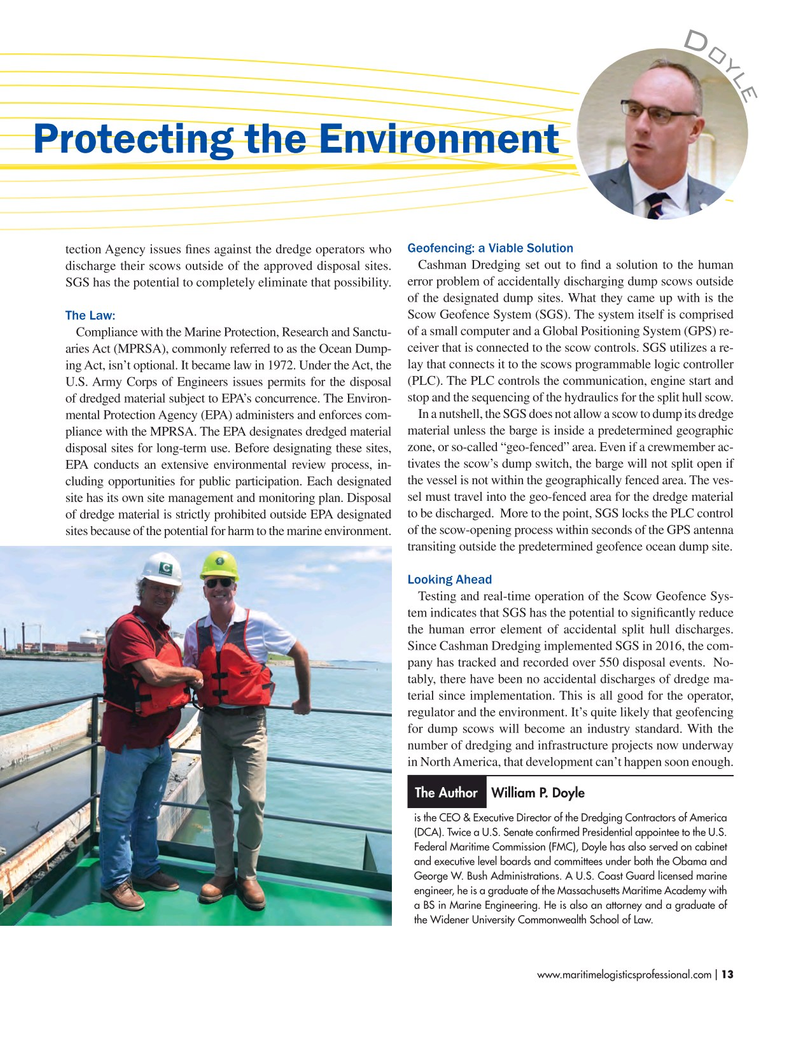
Page 13: of Maritime Logistics Professional Magazine (Jul/Aug 2018)
Port Infrastructure & Development
Read this page in Pdf, Flash or Html5 edition of Jul/Aug 2018 Maritime Logistics Professional Magazine
D
O
Y
L
E
Protecting the Environment tection Agency issues ? nes against the dredge operators who Geofencing: a Viable Solution discharge their scows outside of the approved disposal sites. Cashman Dredging set out to ? nd a solution to the human
SGS has the potential to completely eliminate that possibility. error problem of accidentally discharging dump scows outside of the designated dump sites. What they came up with is the
The Law: Scow Geofence System (SGS). The system itself is comprised
Compliance with the Marine Protection, Research and Sanctu- of a small computer and a Global Positioning System (GPS) re- aries Act (MPRSA), commonly referred to as the Ocean Dump- ceiver that is connected to the scow controls. SGS utilizes a re- ing Act, isn’t optional. It became law in 1972. Under the Act, the lay that connects it to the scows programmable logic controller
U.S. Army Corps of Engineers issues permits for the disposal (PLC). The PLC controls the communication, engine start and of dredged material subject to EPA’s concurrence. The Environ- stop and the sequencing of the hydraulics for the split hull scow. mental Protection Agency (EPA) administers and enforces com- In a nutshell, the SGS does not allow a scow to dump its dredge pliance with the MPRSA. The EPA designates dredged material material unless the barge is inside a predetermined geographic disposal sites for long-term use. Before designating these sites, zone, or so-called “geo-fenced” area. Even if a crewmember ac-
EPA conducts an extensive environmental review process, in- tivates the scow’s dump switch, the barge will not split open if cluding opportunities for public participation. Each designated the vessel is not within the geographically fenced area. The ves- site has its own site management and monitoring plan. Disposal sel must travel into the geo-fenced area for the dredge material of dredge material is strictly prohibited outside EPA designated to be discharged. More to the point, SGS locks the PLC control sites because of the potential for harm to the marine environment. of the scow-opening process within seconds of the GPS antenna transiting outside the predetermined geofence ocean dump site.
Looking Ahead
Testing and real-time operation of the Scow Geofence Sys- tem indicates that SGS has the potential to signi? cantly reduce the human error element of accidental split hull discharges.
Since Cashman Dredging implemented SGS in 2016, the com- pany has tracked and recorded over 550 disposal events. No- tably, there have been no accidental discharges of dredge ma- terial since implementation. This is all good for the operator, regulator and the environment. It’s quite likely that geofencing for dump scows will become an industry standard. With the number of dredging and infrastructure projects now underway in North America, that development can’t happen soon enough.
The Author William P. Doyle is the CEO & Executive Director of the Dredging Contractors of America (DCA). Twice a U.S. Senate con? rmed Presidential appointee to the U.S.
Federal Maritime Commission (FMC), Doyle has also served on cabinet and executive level boards and committees under both the Obama and
George W. Bush Administrations. A U.S. Coast Guard licensed marine engineer, he is a graduate of the Massachusetts Maritime Academy with a BS in Marine Engineering. He is also an attorney and a graduate of the Widener University Commonwealth School of Law. www.maritimelogisticsprofessional.com 13
I 1-17 MLP JulyAug18.indd 13 1-17 MLP JulyAug18.indd 13 8/8/2018 9:03:37 AM8/8/2018 9:03:37 AM

 12
12

 14
14
